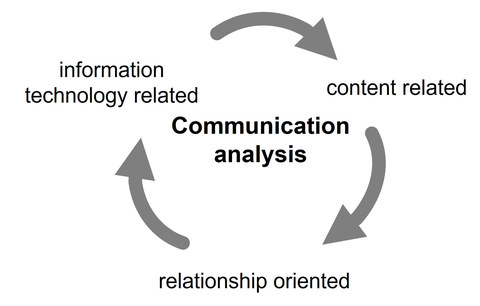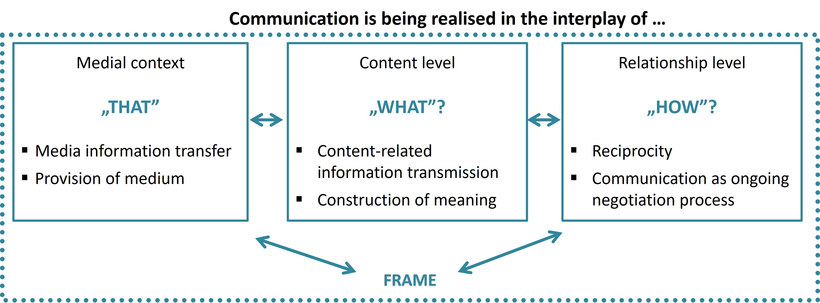Communication is a term that is as difficult to define as culture because it is used in different academic contexts. It is derived from the Latin word communicare and relates to the words “common”, “commune”, and “community”, which can be interpreted as the activity of ‘bringing together’ or ‘sharing meaning’ and a common understanding. From such a perspective, communication can be understood as a process among people that aims at developing a shared understanding of something and thus developing a shared reality. (cf. Cobley, J. 2008)

Perspectives from which communication processes can be analysed
Source: Bolten, 2015, p. 12, adapted and translated
Following Bolten (2015, p. 12), communication can be analysed by considering the technical, content and the relational level. On the technical level, communication is referred to as the actual process of transmission and thus the quality and quantity of the information transfer. This is the basis of the well-known communication model by Shannon and Weaver which was first published in 1948. Its value lies in the understanding that information can get lost or distorted in the process of transmission. As today most of our communication scenarios are media-based and wireless, it reminds us to pay attention to technological disruptions such as signal impairment, radio black spots, server, or bandwidth issues along with the asynchronous communication that these problems cause. Asynchronous communication relates to communication that is sent at irregular intervals, such as an email or chat message, and is stored until the recipient chooses to or can access it.
However, reducing communication to a purely technical level would only tell us about the means of transporting information and possible sources of technical disruption, but not about the content of communication nor about what actually happens in the course of the communication process.
If we examine the content level of communication, we see that not only words but also gestures, sounds and other forms of signs and symbols can have a content mediating function. For example, when dusk falls, it is a clear sign that night is approaching. This is therefore a sign based on context. Equally, waving one’s hand is often used as a sign of farewell or a greeting. The important thing when using signs and other symbols is to acknowledge that their meaning is socially conventionalised and not necessarily shared. The content level of a message thus refers to “what” is expected to be understood. In this regard we need to keep in mind that contents are not ’delivered’ from person A to person B but emerge through negotiation in a mutual process of communication. Interpersonal communication is interactive in the sense that it refers to a sequence of communicative moves between two or more people with the goal of reaching a common understanding.
We view communication as interaction because communication is more than simply sharing information, passing on knowledge, exchanging feelings, and points of views. From an interactional point of view, communication also negotiates the relationship people have or establish during communication. The relational level thus refers to the question of “how” communication takes place between people and ’what for’.
Bolten (2015, p. 11 ff.) argues that the medial, content, and relational level are linked and need to be seen as interconnected and dependent on a framework. The framework relates to the context in which the communication process develops, which in turn is co-created by the communicators.
In an overview, this could be depicted as follows:
Interplay between medial, content and relationship level via the hermeneutic framework of communicative processes
Source: Based on Bolten, 2015, p. 20, translated
Image by Marie Seeberger (www.behance.net/marieseeberger) CC-BY-NC-SA 4.0 license
Click on the image for a larger view
As illustrated above, it can be argued that there is an interplay between the medial, content as well as relational level. This supports the understanding of communication as an ongoing process of interaction through a mutual and simultaneous exchange of signs and symbols to create and sustain shared meaning and achieve sense-making in the relationship within a specific context. Communication viewed from such a perspective means that the co-creation of meaning is the basis for achieving our objectives of action.
